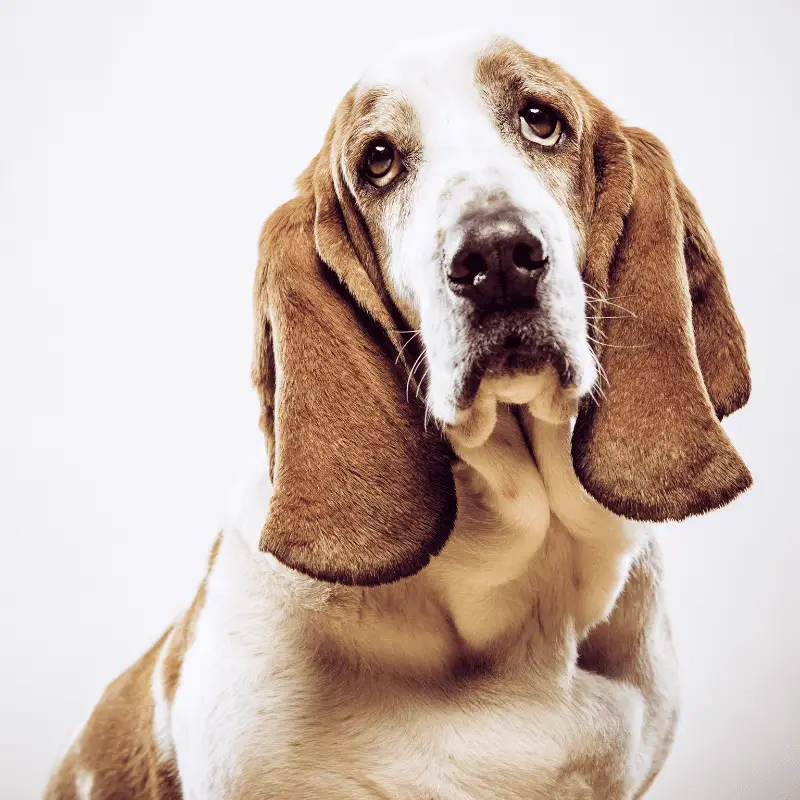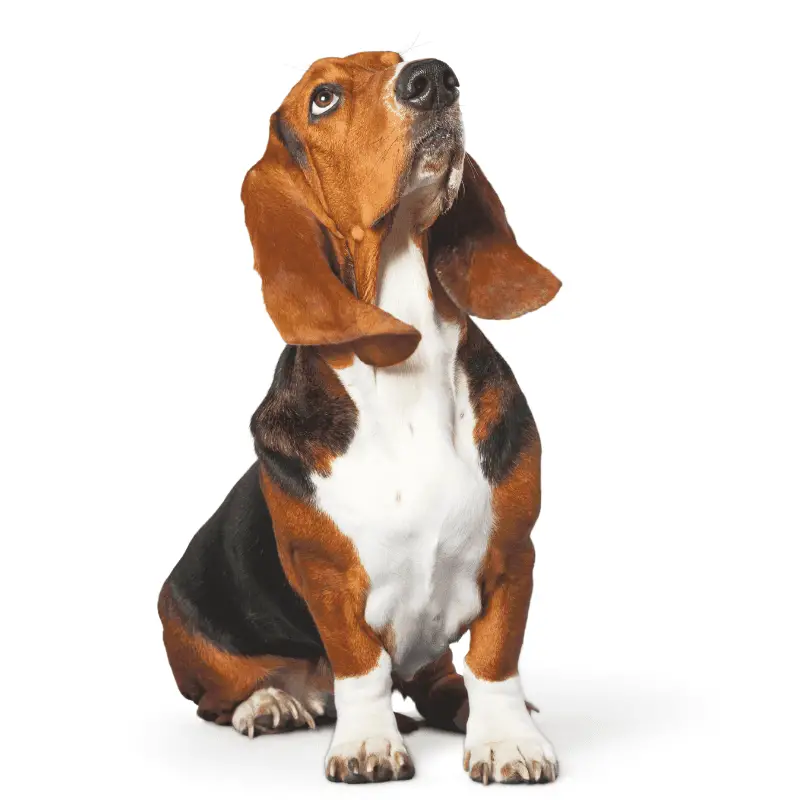Affectionate, adaptable, and relaxed, there are hardly any dog breeds out there that appeal to the novice pet parents as the Basset Hounds do. Their placid personality, deep eyes, and long ears make these dogs look all too cute. But, if you are thinking about adopting one Basset Hound, understand that you need to create a structured exercise routine for them. These dogs thrive when you keep them on moderate exercise and a proper diet. If you do not do that and give in to the easy-going charm, then both of you will be in a lot of trouble. Lack of exercise can lead to weight gain leading to significantly serious health troubles. If you can keep your pet Basset Hound active while ignoring all their reluctance and protests, you will have a loving pet who will remain your companion for a long time.
Appearance
The short legs, long ears, and droopy eyes are some of the most prominent characteristics of the Basset Hounds. The Basset Hound is also known as the hush puppies. These dogs have a non-confrontational, gentle demeanour, making them a favourite among dog lovers. The breed is also known for its hunting instincts, and the breed was initially developed for assisting in hare and rabbit hunting expeditions. This dog breed is a multi-purpose breed that excels in tracking, confirmation, and obedience. Their gentle nature helps them to hunt in packs as well. These hounds come with a short-haired coat which is suitable for all weather. Whether chasing prey or playing with their humans, you will always find a Basset Hound happy.

History Timeline
The Basset Hounds belong to a family of hounds known as the scent hounds. The breed’s name was derived from the fact that these dogs depend on their senses to hunt for prey. The keen sense of smell of these hounds comes only next to the smelling power of the bloodhounds. The mention of the Basset Hounds can be traced long back in history.
Ancient Times
The presence of the Basset Hounds can be traced back to ancient times. Pieces of evidence and engravings have shown the existence of short-legged hounds in Egypt. It is considered one of the hound’s first recordings in some form.
6th Century
The Basset Hounds were first developed in France, known for the variations of their hound breeds. The Basset Hound is a descendant of the very famous St. Hubert’s hounds.
St. Hubert was one of the churchmen of France who wanted to develop a different breed of hounds. The hounds he set looked surprisingly similar to today’s bloodhounds. Experts consider that the Basset Hounds were developed through mutation of the St. Hubert’s strains. The modification helped to develop short-legged dwarfed hounds. These hounds were, most probably, kept as an object of curiosity. However, the owners later discovered the exceptional tracking abilities of these hounds. When that happened, the Basset Hounds were bred on purpose. The tiny legs reduced the speed of the hound significantly, which in turn helped those hunters who were searching for small games on foot. The term Basset in French means low. It signifies a hound with a short height.
1585
The first explicit mention of Basset Hounds was found in an illustrated book explaining various hunting aspects. Named as La Venerie, the book was penned by Jacques du Fouilloux. This year, the book contains a clear image of a Basset Hound that resembles the present-day Basset Artesian Norman significantly.
The 1700s
The Basset Hounds were a favourite to the french aristocrats of this time. They often take the hound with them while going for small game hunting. However, this tradition changed after the french revolution took place. In this revolution, French Hunting dogs suffered almost a similar fate as the French aristocracy. Most of these hounds were either killed or dispersed. Only a couple of dogs escaped the aftermath of the revolution. Once the order was restored, these dogs were interbred and even crossed with English bloodhounds. It helped to replenish the almost empty kennels of France.
After the revolution, the Basset Hound turned into the dog of the commoners. As they did not have access to horses, they wanted to find a dog they could follow on foot while hunting.
1866
The Basset Hound made their way to England in 1866. This year, Lord Galway brought a pair of Basset Hounds to England. This pair of dogs produce a litter of five puppies. However, as Lord Galway did not use these dogs in the dog shows, their whereabouts have remained unknown.

1872
The Basset Hound was first introduced to the English Dog Show this year.
1874
This year, Sir Everett Millais brought a Basset Hound from France named Model and started a breeding kennel independently. Sir Everett Millais also took part in the breeding programs of George Krehl and Lord Onslow. His efforts gained the Basset Hound recognition in England, and for that, he became famous as the father of the breed in the country.
1875
Sir Millais first showcased his Bassets in a dog show this year. Even though the show was successful, the puppies did not gain much recognition. During this time, the benefit of Millais became the arrival of the dogs of the fourth Earl of Onslow. It is possible that the earl already possessed Basset Hounds but only for hunting and not for show. The success of Millais and the interest of Onslow prodded others to take an interest in this breed. These dogs were not famous till the next couple of years.
1880
This year, Sir Millais and Onslow offered all the Basset Hound class entries in the Wolverhampton show. After completing this show, the public started to take note of the Basset puppies. This year, the Kennel Club also recognised the Basset breed. However, both men abandoned the breed soon after this show was over. The baton of breeding the Basset hounds was handed over to Krehl.
1882
Basset Hounds were first included in the book called Dogs of British Island in 1882. It was George Krehl who wrote the chapter on the Basset Hound.
The 1890s
During this time, the British hunting fraternity took up the responsibility of breeding and keeping the Basset Hounds. While it helped maintain the line of Basset Hounds intact, it also created many disputes about correct breeding techniques.
Even though the dog was used for hunting rabbits in France, the British fraternity considered it impossible. However, in the 1899 edition of British Dogs, Frederick Blaine mentioned that the Basset Hounds are not as slow as British people imagine. These dogs can go on for hours, which shows excellent endurance. He hoped that the British eternity would not consider the dogs’ heavy and somewhat ugly appearance and would consider their qualities instead.
The 1900s
The breed did not make a mark of their own in the US till 20th Century. Even though the American Kennel club started registering the Basset Hounds in 1885, they did not recognise the breed till 1916. The first Basset Hound that the AKC registered was named Bouncer.
1928
This year, 1928, proved to be a turning point for the Basset Hounds in America. The Times Magazine featured a Basset Hound on their front cover. They also ran a story about the 52nd annual dog show with Westminster Kennel Club. It was held at Madison Square Garden. The story was written from the point of view of that Basset Hound. This story helped the Americans discover the Basset Hounds’ charming nature. These hounds did not need to look back ever again from this point on.
The 1960s
During this time, the Basset Hounds entered the world of pop culture with a bang. They appeared in the advertisement for the Hushpuppy shoes and were also featured on the comic strip of Fred Basset. The exciting thing is this comic strip is running even today.
The 2000s
Basset Hounds did not lose their popularity in the 21st Century. They have secured the 28th rank on the list of most popular dog breeds published by AKC. Throughout the United States and other countries worldwide, people celebrated love for the Basset Hounds.
Basset waddles and picnics have become a tradition in many regions worldwide. Most of the time, these events bring out thousands of Basset Hounds and their families.
Conclusion
The independent nature of the Basset Hound makes it a bit tough to train them. Over the years, different hounds of this type have been developed to hunt independently. That is one of the reasons why the Basset Hound can seem a bit aloof. They may not be interested in following your orders right away, although it’s undoubtedly achievable to train a Basset Hound if you have time and persistence. Consistency is yet another factor that will help you offer positive obedience training.








